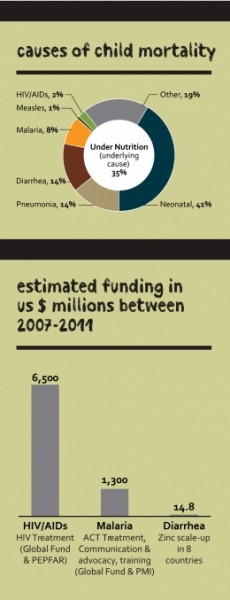This is a guest post is from Healthy Lives editor Mark Leon Goldberg.
Mark Leon Goldberg here. The following article is from the most recent issue of PSI Impact Magazine, a quarterly publication from the global health NGO Population Services International. The cover story, written by Desmond Chavasse, Ph.D, Vice President, Malaria Control & Child Survival, PSI takes a look at some high-impact, low cost interventions that could greatly improve child health in the developing world. The solutions are relatively simple, but we need more political will (and funding) to fully realize their potential. From the article:
THE GOOD NEWS: More children are living healthier lives around the world than at any other time in history. Child mortality rates are on a steady decline, from 12 million deaths in 1990 to 7.6 million1 deaths in 2010.
THE BAD NEWS: Nearly half of the deaths that still occur are due to diarrhea, pneumonia, malaria and neonatal causes. Furthermore, under-nutrition is considered an underlying cause in almost a third of deaths of children under five.
———
As the 2015 deadline for meeting the Millennium Development Goals (MDG) approaches, there is mounting pressure to reduce child mortality by two-thirds (MDG4) and reduce by 50 percent the proportion of people without sustainable access to safe drinking water and basic sanitation (MDG7).
While we have proven and cost-effective interventions to address the major causes of child mortality, accelerated progress is hindered by insufficient and inadequately coordinated funds that would ensure these interventions are implemented at the scale required to significantly improve the health of nations. Cost-effective interventions – such as diarrhea treatment kits (oral rehydration salts and zinc); increasing access to, and rational use of, antibiotics for pneumonia treatment; promotion of hand-washing with soap and micronutrient fortification of food – need to be scaled up if we are to meet the 2015 development goals.
However, funding for these interventions lags behind other health interventions despite the relative importance of diarrhea, pneumonia and under-nutrition in causing child mortality. Additionally, donor consensus on integrated programming remains low despite the obvious health delivery synergies and economies of scale. As a result, adequate funding is not flowing.

You can read the rest here, in which some of the innovations are discussed. I encourage people interested in maternal health and child survival to peruse our recent issue. It covers issues from new ways to get fortified foods to children who need them the most to the challenges facing the early diagnosis and treatment of children living with HIV. Check out the whole issue!